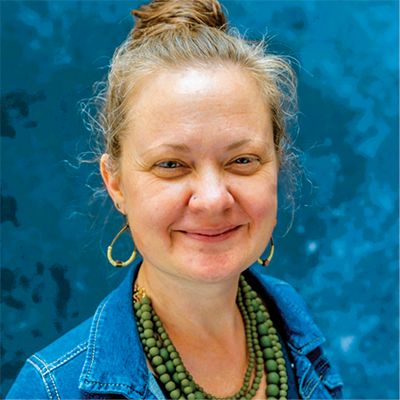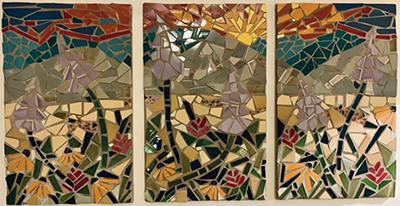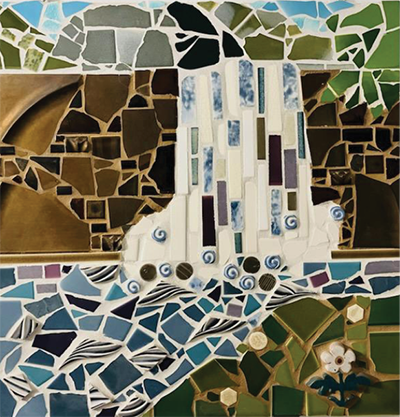Katie Mechler, MD

Affiliation
UPMC
Years in Hospice
and Palliative Medicine
12
Medium
Mosaics
Watch the Interview
Artist Q&A
How did you get started with your art, and describe if it has changed over your hospice and palliative care career?
One day in college I was in Barnes and Noble bookstore, and I happened to see a book on mosaicking—I’m not sure why I found it, but I saw it and thought that it looked like fun. The Home Depot was in the same shopping center, so I just went and bought the materials and started the next day! I found it so enjoyable, deep, and spiritual. There’s something so cathartic about smashing tile into lots of different pieces and bringing it back together to form something completely different. Through the years the main change is the tools I use. Now I sometimes use a wet saw to get precise cuts but, let me tell you, there’s nothing better than hitting tiles with a hammer—divine stress relief! I’ve grown in confidence and made bigger pieces. The time I have to create is now shorter, as I put my creative energy into my garden in the spring and summer, but I return to mosaics every year in the late summer and fall.

What is your creative process?
I have a tiny studio in my basement where I keep interesting tiles that I collect over time. When I have an idea, I can go there and pick the right color palate from my many tiles. I find my ideas from nature: my garden, places I’ve been, and places I want to go. I’ll pencil a rough design onto the wood back but then it’s time to smash the tiles and lay out the rough pieces. This is the best part. It’s like a jigsaw puzzle, looking closely at the shards and finding the pieces that just fit. Sometimes you have to get out the hammer and smash it again to make it fit. Then I step back and try to get some perspective, look at the big picture, visualize it as a cohesive piece. Next, I glue the pieces in place and take it outside to mix and apply the grout. Grouting is a process of patience: cover the piece in grout, then wipe it off with a sponge when it’s dry enough but not too set. The final step is hand painting sealant to all the grout. It’s fully ready 24 hours later.
Describe your art in seven words or less.
Broken and restored in a new way.


What do you want people to take away from your art?
I create mainly landscapes, including one of Mount Hood, which is near where I did my palliative fellowship. If people look at my mosaics, I hope they get a sense of joy and inspiration. If that’s what they get, I am happy with that.
What are future plans for your art?
I would love to go to Barcelona because I’m inspired by Gaudí and all mosaics he did. Until then I will work on my humble pieces. I’m planning to create the Giant’s Causeway with some nice, layered glass tiles, and then I’m making another waterfall piece, which will be like a cascade of tiny blue tiles.
How do you deal with perfectionism and the inner critic in your art?
Well, I have to remind myself that all of my pieces are broken and intentionally irregular at times. And I tell myself that grout covers up a lot of imperfections. Mosaic making as an art is more forgiving at times—until the grout hardens at least. I feel like once the grout dries, then comes a wave of acceptance. This is art, a journey!
What advice do you have for your younger self, or what do you want our readers to know?

I would definitely tell myself, “Remember not to let the grout dry all the way before you start wiping it off!” Grout is hard to remove from tile once it’s fully set. It really is an exciting moment when the extra grout is wiped away and your piece is revealed for the first time. For anyone who has ever thought about mosaicking: it’s so easy, you should try it! You can start with a kit so that you don’t have to worry about making a big mess. Otherwise, the supplies you need are a piece of wood, strong glue, tile, and a smashing device of your choice. I advise wearing safety goggles and gloves, too. Mosaicking is just so much fun and each piece is one of a kind. The satisfaction you’ll get from planning and creating it will fill your soul!
This interview has been edited.
Calling all AAHPM member artists: painters, photographers, sculptors, potters, quilters, digital artists, cartoonists, even doodlers—casual or serious creators of any kind!
Artist in Residence is a new column that seeks to highlight AAHPM members who create art as part of their professional or private lives and wish to share said art with the AAHPM community to encourage connection and healing. Email [email protected] if you would like to be considered for the next Artist in Residence.